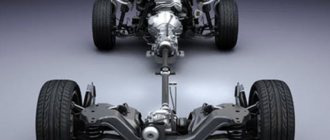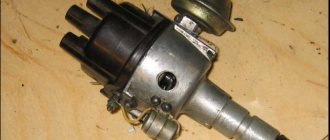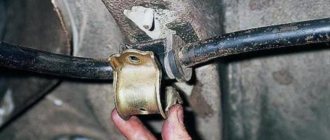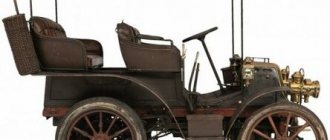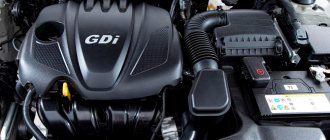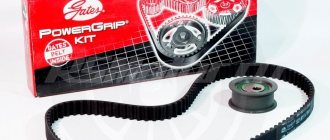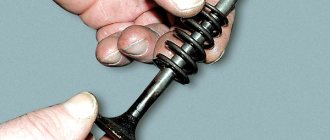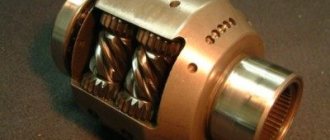When getting into a car, every experienced motorist pays first of all attention to the smooth ride of the vehicle, which is ensured by its suspension. Most often, this automotive unit is built using shock absorbers with springs. But there is also a category of machines where it is necessary to ensure a high level of load capacity and suspension reliability. For this purpose, springs are used instead of springs. What is a spring and where are they used? This is what will be discussed further
Previously, almost all Soviet cars had rear and sometimes front leaf spring suspension. But over time, it was almost completely replaced by the spring version. So why did this happen? What are the disadvantages specifically for passenger cars?
A spring is an element of a car's suspension that compensates for shocks, shocks and vibrations that occur due to uneven roads. There are several types of car springs: double elliptical, three-quarter, quarter, transverse, half, but they all serve the same purpose - to provide the vehicle with smooth movement and you with a comfortable ride.
Interesting fact! An ordinary village cart could not do without springs. The first primitive analogs of shock absorbers were a regular chain or leather belt.
The design and principle of operation of a car spring
The suspension in your car is not a fundamentally complex engineering structure. Almost every car enthusiast knows what a spring consists of. Usually these are sheets of special steel of different lengths, which are fixed with clamps. In passenger cars, the spring is most often mounted under the axle, and in trucks - above it. The ends of the springs are attached to the body using hinges. An automobile spring transfers the load to the chassis from the body or frame. There are also designs where the leaf spring works in bending, like an elastic beam. It usually uses several sheets. But recently there has been a trend towards more frequent use of monoleaf springs. In such designs, a large role is given to shock absorbers, which seriously help dampen body vibrations. Important! Imported springs dampen vertical vibrations better. They are extremely compact and can be used without shock absorbers.
Determining the path of movement of the leaf spring ears
If a transversely located leaf spring, mounted at two points, simultaneously replaces the upper or lower control arms, then the designer must know the trajectories of the centers of the spring ears when the suspension operates in corners. This is necessary to determine the instantaneous center of rotation, as well as to calculate the change in camber and toe.
The measuring points forming the movement path are obtained using spring scales. The straightened spring () is taken as the starting position. The magnitude of the load does not matter.
Figure 8 – The center of the arc described by the ear of a spring fixed at two points is, as a rule, shifted away from the places of fastening
The initial parameters are the values of the compression strokes f1 and rebound strokes f2 of the suspension in the direction of the Y axis, and the measured value is the lateral displacement Δl of both slides, which gives the corresponding value of X. In the process of studying both attachment points D1 (on the left) and D2 (on the right, on not shown in the figure) must be loaded or unloaded in parallel. The spring is then drawn in a straightened state on a scale of 1:1 so that, based on this position, it is possible to plot the obtained X values in accordance with the Y values. The origin of coordinates is located in the center of the spring eye. By connecting the individual points, we get an arcuate curve at both ends of the spring. The center of curvature serves as the kinematic center of rotation.
A similar process can also be applied to the central fastening of the spring, regardless of whether this fastening is rigid or elastic ().
Figure 9 – When the middle of the spring is rigidly fastened, the center of the arc described when the suspension is operating by the eye is located outside the embedment
With transverse leaf springs, the center of rotation is determined in the same way. With longitudinal leaf springs, determine the trajectory that will be required to clarify the movement of a continuous beam mounted on the springs. In the latter case, the spring should be shown on the drawing in accordance with its position in the car.
Types of springs
In the automotive industry of our time, there are several types of springs, but for ordinary production cars, the leaf type of design is most widespread.
This type is a set of steel sheets that are connected to each other with special clamps and mounted on the chassis of the vehicle.
Since this automotive unit must withstand increased loads, it is made from durable hardened steel. In terms of its shape, this part of the chassis is rectangular steel sheets, which are curved like a “sickle”.
To provide the entire structure with additional elasticity, each sheet is modified so that it has a different degree of curvature. To prevent lateral movement and ensure maximum secure fixation, the sheets are shaped like a groove.
Since springs are always operated under conditions of constant deforming movements, the specifics of their production ensure the highest resistance to mechanical wear.
In modern passenger car models, this type of component is used very rarely. There are several reasons for this. The main one is that passenger cars are usually designed for use at high speeds. At the same time, increased demands are placed on the suspension in terms of reliability and controllability. But the leaf type of springs tends to slightly shift longitudinally the seats of the car to which they are attached. This slightly worsens the car's handling at high speed.
Dependent suspension with guide arms
There is no chance of losing control of the axle in the case of a suspension with guide arms. This is the most common type of dependent suspension. There are a total of 5 levers in this suspension: four longitudinal and one transverse.
Thanks to the presence of levers, excellent endurance is ensured for the following types of forces:
- Vertical;
- Longitudinal;
- Lateral;
In order to give elasticity to the suspension, a spring is used, and a shock absorber is used to absorb shocks.
The presence of a wishbone prevents the car's axle from moving. The lever itself is called a Panhard rod. This type of traction can work differently when turning left or right. More successful mechanisms for the dependent suspension of a car are the Scott-Russell and Watt mechanisms. Below are descriptions of several types of dependent suspension.
Watt's pendant
The Watt mechanism consists of two horizontal arms that are hinged in a vertical position. The lever itself is fixed in the center of the beam and can rotate. When the moment of uneven movement occurs, for example when turning, the vertical lever rotates and compensates for everything.
Scott-Russell suspension
The Scott-Russell mechanism consists of two levers: short and long. The long lever is attached to the body, and the short one is attached to the center and edge of the bridge. The main feature of this mechanism is the elastic fastening to the beam, thanks to which the car better maintains its course and is better controlled.
De Dion pendant
Also an excellent type of dependent suspension is the De Dion suspension. It was developed by the De Dion Bouton company in 1896. It is a structure where the body is separated from the axis. Thanks to this moment, the mass of non-shock-absorbing parts is reduced. Most often, this type of suspension was used in Alfa Romeo cars. Of course, it was only installed backwards.
The De Dion suspension is considered average between dependent and independent suspensions. All parts of this suspension contribute to a lightweight ride and high handling. Due to the fact that De Dion is quite expensive to buy, it is used very rarely, and only on sports cars.
Dependent suspension is very old and its history dates back to carts and carts. Despite this, it can still be found on some cars.
The main advantages of dependent suspension:
- Large stroke, thanks to which you can overcome large obstacles;
- Simple design;
- Excellent stability and strength;
- Constant track width, which is an excellent factor for off-road use;
The main disadvantage is the rigid connection of the wheels, which is why they move along a very similar course, even when passing obstacles. Together with the large weight of the structure, this moment cannot have a positive effect on motion stability and controllability.
Below you can watch a video of how a car's dependent suspension works.
Advantages and disadvantages of springs
An important advantage of leaf spring suspension is its simplicity of design. It is also quite inexpensive and reliable. The spring is not afraid of overloads and bad roads with holes and potholes, which is especially important for our country. The spring is universal. It absorbs not only the loads that arise during braking or acceleration, but also those that appear when cornering. Spring suspensions are also supported by the fact that they are compact, located at the bottom of the car and therefore do not occupy part of the loading area of the trunk. But springs also have disadvantages. Firstly, it wears out quickly.
Advantages
Now that we know what springs are in a car, we can talk about their pros and cons. The first and most important advantage is the maximum simplicity of the design. This determines the low cost, as well as high reliability. If a spring is used in the suspension, then there will be no need to assemble the system with bushings, reaction bars and levers. In addition, the spring tolerates loads and overloads much better when driving off-road and on broken roads.
One more plus can be highlighted - it is versatility. Such a suspension can easily absorb not only vertical loads, but also longitudinal ones. They often occur when braking or accelerating. The spring also smoothes out the lateral loads that occur when cornering.
What are springs? This is a suspension element, which means it should have characteristics such as compactness. The spring is very compact, unlike springs traditional for passenger car suspensions. The element is installed at the bottom, which frees the structure from reducing the loading area of the trunk. This is very important for utility vehicles. In addition, due to the length of the springs, they can be made very comfortable and soft.
Tips for caring for springs
When operating leaf spring suspensions, the driver, first of all, must: • take into account the surface of the roads on which he drives; • do not overload the car; • do not move or brake suddenly; • promptly replace broken sheets with new ones; • listen and pay attention to the rattle of springs; • update graphite lubricant and tighten threaded connections in a timely manner. Therefore, the durability and operating potential of springs depends not only on many design, technological, operational and repair tasks, but also on the professionalism of mechanics and drivers.
Spring arrangement
Most often in the automotive industry, springs are installed on trucks. In this case, the front and rear structures are distinguished.
The front ones are mainly designed to ensure a comfortable ride in the cabin. The rear ones usually have a different purpose - to carry most of the load; for this purpose, this type of automotive unit is reinforced.
This reinforcement is usually achieved by adding more sheets. The lower part of the structure is subjected to the highest load, as a result of which 2-3 special main springs are installed there. Although this solution helps reduce ride comfort, it significantly increases the stiffness of the suspension.
Types of anti-roll bar
There are two types of anti-roll bars: front and rear stabilizers. Some passenger cars do not have a rear cross bar, but a front stabilizer bar is installed on all modern cars.
Active anti-roll bar
The active anti-roll bar makes it possible to control the change in stiffness for different types of road surfaces and driving patterns. For sharper turns, the maximum stiffness is set, on a dirt road the hardness is medium, and off-road the function is turned off.
Why is it rarely installed on passenger cars?
Still, the springs are designed for heavy weights and overloads, but this is not the case on passenger cars! Another feature is that the springs make the suspension much more comfortable (potholes are swallowed “at once”), you will not jump on the seats like on a “goat”.
A spring suspension installed on a passenger car will make the suspension unbearably stiff; any bump will be felt as a “fifth point”. Handling also suffers, because suspension travel is very limited.
To put it simply, on passenger cars, such a design is simply not needed! You will not transport loads of 3 - 5 tons.
The advantage of springs is the simplicity of the design and the resulting low cost because it is both an elastic element and a suspension guide (a device that sets the position of the bridge relative to the car chassis and the kinematics of the suspension).
Also, the compliance of the spring ensures that there are no mismatches in the suspension kinematics during different strokes.
In the garage environment, there is an opinion that if the spring has straightened, it means it has sagged. This is not the case for a non-tilted spring located above the axle. In the static position of the suspension, it should be straight or even, on the contrary, curved towards a greater deflection. Here is an image of the rear suspension of a UAZ Hunter or Patriot:
Kinds
When we know what springs are on a car, we can move on to studying their types and features.
Depending on how the sheet will be used, one of the types is used only on trucks, the main function of which is to transport enormous loads. In this case, the spring must ensure smooth running of the machine. The first type is heavy trucks for transporting metal products, sand, crushed stone, and various building materials. The second type is springs for cars, SUVs, and buses.
Maximum suspension efficiency can only be achieved when the machine is loaded. In all other cases, achieving the required level of comfort will be very difficult.
You can also select semi-elliptical or torsion elements. And although such suspensions are much better in terms of performance compared to leaf-type springs, they require special maintenance and attention.
Main functions of the suspension
First of all, it should be noted that it is the suspension elements that connect the car body to the tires
. Without this element, the car turns into an ordinary cart, which shakes at the slightest irregularity.
The second and also important function of the suspension elements can be called increasing the stability of the car.
When making turns and U-turns, the vehicle is subject to external lateral loads that can cause it to roll over. The suspension ensures the stability of the car, ensuring the safety of those in the cabin.
Important part of the suspension
A spring is an elastic component of a car’s suspension, which ensures the distribution of the body load on its chassis. Also serves to soften shocks and vibrations while driving.
It is this element of the vehicle’s chassis that compensates for various vibrations caused by road defects. As a result, such a design is an important component of the car, ensuring its comfortable use for passengers.
Springs are connected metal plates. This is a strong, inexpensive and very durable structural element that provides the characteristics necessary for comfortable use of the machine when driving on bad roads. This design does not require any special care; it is not affected by dirt, moisture, crushed stone or gravel.
Design of hanging elements
Any suspension consists of three components:
- damping component;
- guide component;
- elastic component.
The damping component, as the name suggests, is needed to dampen various irregularities that occur along the vehicle’s path. Shock absorbers are most often used as this component.
The guiding component is represented by levers that serve to connect the chassis and body of the car.
It is generally accepted that there are two types of suspensions: mechanical and pneumatic. However, some suspension components also combine electrical and hydraulic components to help achieve a smoother ride on the road. Sometimes the electronic control unit is responsible for the operation of the suspension.
History of leaf spring suspension
Suspension systems of this type appeared many years ago. In ancient Rome, springs were sometimes used on carts. The elastic elements were leather belts or metal chains. The use of such suspension systems made it possible to transport large loads without the potential danger of damaging axles and wheels.
Most trucks have spring suspension in their design, which allows them to transport large cargo over long distances and on bad roads without fear of unexpected damage to axles and wheels.
And it’s all about her... about the spring
The spring is much older than the car. For example, Gogol’s characters who discussed “will the wheel get there…” were most likely looking at the spring stroller. Naturally, the runaway crews also inherited it. At different times it was very widely, sometimes almost completely used in car suspensions. And today you can find many simply stunning designs on old technology. But we will not analyze them here, since the practical value of this information is small, and for a decent review you will need much more space than is available in the entire magazine. Therefore, let’s talk about what has crystallized in the process of development to date.
A spring is a spring that is a plate or a set of plates that bend. Accordingly, being a spring, it has properties inherent in all springs. And if on a particular car model the spring suspension is stiffer than the spring one, this is only because the spring was made stiffer for some reason. However, there are also some peculiarities. So, if a coil spring is practically indestructible by compression - the coils will fall on top of each other and the axles, wheels and frame are more likely to collapse than the compressed spring, then the spring will bend until it is completely or partially destroyed. By the way, exactly the same as an expandable coil spring. Hence the first purely practical consequence: do not forget to take a look at the bump stops and suspension travel limiters, especially if you have to work with overload.
Spring stiffness depends on many parameters, but all of them can be assessed with the naked eye. So, it is directly proportional to the width of the sheet and the number of sheets, inversely proportional to the length and proportional to the cube of the sheet thickness. This rule, which may look very scientific, can be useful. For example, if you have to look for a replacement for a broken spring for a foreign car that is unique in your area. By the way, in the Russian outback the author came across very rare European trucks.
Springs can be multi-leaf, few-leaf or single-leaf. Until recently, multi-leaf springs were, and still are, the most common in our country today. Since the graph of the change in the bending moment of the spring has the shape of a triangle with the vertex at the loading point (bridge), this triangle is “filled with sheets” in order to obtain more uniform stresses in each of them. As a result, it is possible to kill not one, not two, but a whole herd of hares.
Firstly, the result is a very rigid structure in the longitudinal direction, which makes it possible to do without reaction rods or other bridge-holding devices. Secondly, all sheets are in approximately equal conditions, which is especially important for a structure that is constantly “playing” on uneven surfaces, which means they last approximately the same time. Thirdly, the sheets pulled together by stepladders rub together during the deflection process, dampening the rocking of the car. In many cases, this allows you to do just fine without any shock absorbers. Finally, the sheer abundance of sheets opens up scope for design imagination, for example, for obtaining a nonlinear characteristic close to ideal. True, reliability suffers along the way, and reputable car builders do not sin with such things, preferring to use additional springs (“cushions”) and tricky supports.
For the production of sheets, hot-rolled strip of carbon spring steel is usually used. The required bend is given by straightening, and in the factory - in stamps. After this, heat treatment is done. Often the surface is hardened by shot blasting.
Until some time, the cross-section of the sheet was rectangular with rounded edges. But since fatigue failure of sheets almost always starts at the top, the bottom surface was reduced with bevels or notches. As a result, the cross-section of the leaves of most modern springs is either trapezoidal or a kind of “T” with a very thick leg. As usual, this solution also has a “downside”: the cracks formed after assembling the multi-leaf spring serve as excellent dirt collectors and moisture accumulators. All this could be ignored and forgotten if dirt and rust were not excellent abrasives that grind the sheets. Hence another practical recommendation: do not forget to look at those places where the bottom sheets end - there the top sheet wears out more.
In detailed technical specifications, domestic factories traditionally report that “the suspension is on longitudinal quarter-elliptic springs.” Such a refinement of the bending shape of the sheets made sense at a time when spring suspensions were widespread, when structures consisting of several springs were used as an elastic element. Today, with the only surviving type of multi-leaf spring in common use, the shape of the camber is determined more by design considerations than by operating characteristics.
When reassembling the spring, it should be borne in mind that the curvature of all sheets must be the same and they must be adjacent to each other over the entire surface. Otherwise, prestressing of some sheets occurs, which will sharply reduce their service life, and you should not be surprised that the car will “sit” on one wheel after some time.
The spring is almost always attached to the bridge with stepladders - either from above or from below (there is no talk about a balancer suspension). But the design of spring fastenings to the frame can be of three types. Let's call them "light", "medium" and "heavy".
In the first case, both ends of the main leaf of the spring are bent into rings under cylindrical silent blocks, through which they are attached on one side to the bracket on the frame, and on the other to the shackle. Today it is believed that the spring should be attached to the frame at the front end. This is exactly how almost all car builders install them. However, sometimes you come across cars (oddly enough, quite new in age) with springs positioned “back to front”. Silent blocks, as a rule, are rubber bushings. The design is good in that it dampens vibrations well and does not require maintenance, but its regular inspection is simply necessary. The load capacity of such spring mounting is not great, however, there are quite heavy cars whose suspension is made in this way. An example is the Renault Mascott with a gross vehicle weight of seven tons. Basically, the light type is used on a few passenger cars that have retained spring suspension to this day, as well as on trucks with a “passenger” gross weight.
The second option is to embed the front end of the spring into three cushions (upper, lower and front - to limit longitudinal movement), and the rear end into only two (upper and lower). This design is well known from the Ulyanovsk “loaves” and Nizhny Novgorod medium-duty trucks from GAZ-53 and later. No maintenance required. It is very reliable, but dampens vibrations somewhat worse than the “light” one. Assembling the mount is associated with certain inconveniences, although not major ones. Despite its obvious advantages, it is not particularly popular among Western automakers.
Finally, a tough episode. There are no rubber bushings or cushions in it. A sliding bearing housing is attached to the front end of the main sheet, into the hole of which a rather massive steel pin is inserted, fixed in a bracket on the frame. The working surface of the finger is most often cylindrical, but there are models that have a threaded friction surface. The beauty of this design is that it limits the axial movement of the spring, and in addition, the friction zone is well protected from water and dirt (with lubrication, of course). Its biggest disadvantage is the difficulty of repair, and in addition, in a neglected state, the threaded pair, rubbing “steel on steel,” becomes non-separable. True, to get such a result you need to try hard.
The rear end of the root leaf usually rests on a cylindrical support. When the spring bends, the leaf rolls over the support, the working length of the spring decreases, and its stiffness increases. This design perfectly transfers all vibrations to the frame, but is capable of withstanding enormous loads. It is very durable, but requires timely lubrication. It is noteworthy that this solution is also found on relatively light trucks, but their rear end can also be attached with an earring.
As you know, the biggest disadvantages are continuations of advantages. And if interleaf friction dampens the rocking, then only after the movement begins. And if you take into account that static friction is greater than sliding friction, you get an interesting situation: on a smooth road, the forces on the spring are not sufficient to move the sheets relative to each other, and the spring does not bend at all. That’s why multi-leaf springs are called “bad road suspension.”
They tried to fight this phenomenon. For example, Moscow taxi drivers and personal car drivers removed the rear springs from a GAZ-24, lubricated them with graphite lubricant, packed them in a case, and then put them in place. It’s clear that no one has done anything like this on trucks. However, if you really have to sort out the suspension and springs, then you can lay transformer paper sprinkled with graphite (but not grease!) between the sheets. Some people put Teflon or polyethylene film there, but these materials leak under load. In addition, after reducing interleaf friction, the energy intensity of standard shock absorbers may in some cases be insufficient. Of course, where shock absorbers are not provided by the manufacturer, interleaf friction should not be dealt with.
It was interleaf friction that became the reason that multi-leaf springs began to be replaced by small-leaf and even single-leaf springs. This occurs to a greater extent in light truck classes and passenger vehicles. There is only one fundamental difference between such springs: the leaf in them is not necessarily made of a strip with a constant thickness and cross-sectional shape. If there is more than one sheet, then they no longer necessarily fit tightly together; more often the opposite can be observed.
Theoretically (and practically), a burst leaf, even a radical one, in a multi-leaf spring most often does not lead to serious consequences. But in a low-spring, and even more so in a single-leaf spring, the same event results in a vehicle failure. However, well-made springs of all types are approximately equally reliable. And since destruction is most often of a fatigue nature and begins with a crack, timely technical inspections guarantee against troubles on the road.
Today, springs are increasingly being replaced by air suspension. Their main advantage is the ability to change ground clearance and stiffness as needed, and they are also electronically controlled. At the same time, the springs are gradually losing ground. It may seem that the spring's days are numbered.
Indeed, from the point of view of a designer, a spring is an inconvenient object.
The stresses in its material depend on the deformation, and with it not everything is simple. In addition, the spring bends under load, when the axles are skewed it twists, acceleration and braking also twist it, but in a different plane, and in addition, it also serves as a reaction rod, absorbs lateral loads, and all this in the presence of road irregularities! All this predetermines the impossibility of simple and accurate design calculations, and makes modeling very difficult. Nevertheless, manufacturers, relying on experience dating back hundreds of years, make springs and put them on trucks, because in many cases they remain the best solution. Modern research is opening new horizons for springs. Thus, thanks to composite materials, you can reduce weight and achieve almost any characteristic; moreover, you can install internal damping and say goodbye to shock absorbers. Price? Oddly enough, when using fiberglass it turns out to be quite acceptable. But this is a question for the future. In the meantime, iron reigns in the spring industry. And there is a lot of it. In any case, it will be enough for our lifetime. Share
Design and operation of spring suspension
This suspension element is represented by metal springs - steel sheets of different lengths, which are fastened together with clamps. The center of the steel sheets is responsible for attaching the suspension to the vehicle axle. The ends of the sheets are attached to the machine frame using hinges or earrings.
It is not necessary to use several sheets, so in the middle of the last century in America, suspension systems with a single metal sheet were used. Similar systems were installed on Ford cars, and only a few years later this system gained popularity among European automakers.
When hitting an obstacle, the spring leaves bend slightly, thus dampening all vibrations resulting from the collision. If there are several sheets, a greater load falls on the lower spring, so it is made shorter, while achieving the least bending. On the contrary, the upper springs are made longer in order to achieve greater flexibility and dampen the remaining vibrations after the lower sheets.
Inspection and testing of springs
Upon acceptance, manufactured springs are inspected, their main dimensions, the tightness of the clamp, their hardness are checked, and then they are tested on a press.
The shape and dimensions of the springs, as well as their tolerances, must comply with the approved drawings and technical specifications. Deviations in length and chord of the spring in the free state should not exceed:
- ±3 mm for springs with a chord length of up to 600 mm;
- ±5 mm – from 600 to 1500 mm;
- ±7 mm – over 1500 mm.
Deflections of the deflection arm against the landscape dimensions are allowed for suspended (unclosed) leaf springs up to 5 mm, for elliptical ones - for passenger cars up to 12 mm and for freight cars - up to 6 mm.
The clamp should be located in the middle of the spring. The asymmetry of the axes of the supporting surfaces of the main sheets, as well as the asymmetry of the ends of the stepped part of the spring in relation to the axis of the clamp should not exceed 3 mm. The clamp must fit snugly; Gaps are allowed: between the clamp and the base sheet no more than 0.1 mm, up to 15 mm deep, and between the clamp and the bottom sheet no more than 0.3 mm; between the clamp and the side edges of individual non-adjacent sheets of 0.5 mm of any depth and between the clamp and the sheets in its corners - no more than 1.5 mm.
The fit of adjacent sheets must be sufficiently tight both in the free and loaded state of the spring. Gaps between sheets directly near the clamp are allowed up to 0.2 mm, and on the remaining length of the sheet - 1.5 mm. The size of the gap between the surfaces of the spring leaves is checked with a flat feeler gauge 10 mm wide, and in the corners of the clamp with a round rod with a diameter of 1.5 mm. Gaps between the tips and sheets of closed multi-row springs are allowed up to 0.4 mm, and a 0.2 mm thick feeler gauge should not reach the body of the rivet or bolt. Chasing or additional compression of loose rivets is not permitted.
Pros and cons of springs
The most obvious advantage of metal sheets is ease of manufacture, and therefore lower cost. Such designs are also reliable, since it is extremely difficult to break thick layers of metal.
Cars with spring systems are unpretentious to the quality of roads - they can move freely along desert highways.
In addition, the cargo in the trunk will in no way affect the sagging of the car, since all the loads from it will be absorbed by the spring.
The main disadvantage of springs is the low service life of metal sheets.
Frequent loads lead to subsidence of the metal, which results in grinding and rattling during the movement process. The spring will require constant lubrication, and the gaskets will often have to be changed.
Some car enthusiasts who use springs complain about constant costs, which are so high that the feasibility of using spring suspension becomes questionable. In some cases, it is easier to install a hydropneumatic suspension element, even despite its high cost.
The use of spring systems on passenger cars is extremely rare. But if you operate a truck that constantly transports goods, the leaf spring suspension will show itself in all its glory.
Video about which suspension is better:
Ring springs
Ring springs are used primarily in cases where it is necessary to provide high rigidity in small dimensions (for example, in some designs of automatic coupler draft gears). This is achieved through the rational use of ring material and the presence of friction forces between the rings. Lubricant is used to ensure stable friction and prevent jamming.
Ring springs (Fig. 4, a) are a rigid elastic element for absorbing compressive axial loads. A ring spring consists of a set of heat-treated rings that are in contact with conical surfaces. Under the influence of load P, despite significant frictional forces on the conical surfaces of the rings, which prevent their relative sliding, they slide into one another. The rings, transmitting forces through their conical surfaces, are deformed: the outer ones are subject to elastic tension, and the inner ones are subject to elastic compression. As a result, the overall spring height H is reduced. After removing the load, since the cone angle β is greater than the friction angle p = arct μ (where μ is the sliding friction coefficient), the spring restores its previous dimensions due to elastic forces. The mutual movement of the rings is usually insignificant (1.5–4.5 mm), as a result of which it is necessary to have a large number of rings to obtain sufficient deflection.
Rice. 4 – Ring spring and diagram of its operation
The amount of work done by the friction forces between the rings (Fig. 4, b) performed when the spring is loaded depends on the accuracy of their manufacture and the presence of lubricant.

